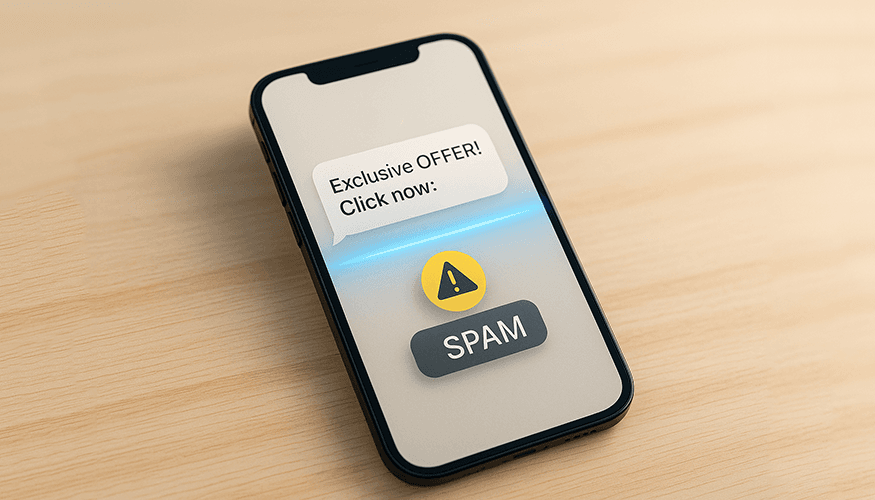Table of Contents
- Learn which SMS spam trigger words hurt deliverability and how to rewrite them safely. Discover proven strategies to stay compliant, improve sender reputation, and reach every inbox.
- How to Avoid SMS Spam Filters
- Why Texts Get Flagged
- Common SMS Spam Trigger Words
- Practical Rewrites: Tigger Words to Avoid
- The Deliverability Playbook
- FAQs
- Put It into Practice with Whippy
Try Whippy for Your Team
Experience how fast, automated communication drives growth.

Learn which SMS spam trigger words hurt deliverability and how to rewrite them safely. Discover proven strategies to stay compliant, improve sender reputation, and reach every inbox.
SMS spam trigger words are risky phrases and writing patterns that, when combined with poor compliance, carrier filtering, or a weak sender reputation, can cause messages to be filtered, throttled, or outright blocked. The problem is rarely one word alone. In modern A2P messaging, keywords alone won’t cause spam — context matters as much as phrasing.
Think of spam filters as multifactor algorithms that weigh content, consent, authentication, and behavioral signals together. A message with perfect grammar but misleading promises or shady/spammy behaviour can still fail; while a promotional text with one or two “risky” terms can pass if it’s transparent, compliant, and properly registered under A2P 10DLC.
Filters examine tone, message content policy compliance, links & attachments, and engagement history. High complaint rates, poor opt-out handling, or sudden traffic spikes quickly reduce trust. Even the cadence of sends, segmentation and consent hygiene, and how your audience interacts (e.g., frequent “STOP” replies) shape your deliverability score.
In short, spam trigger words are only symptoms. To stay out of the gray zone, you need a holistic approach: clean data, contextual copy, brand transparency, and verifiable compliance.
If your organization operates in a regulated industry, learn more in Whippy’s guide to Insurance Automation and SMS Deliverability↗
How to Avoid SMS Spam Filters
Avoiding spam filters is less about censorship and more about proving legitimacy. Carriers and regulators built a web of standards — TCPA compliance, CTIA guidelines, and A2P 10DLC↗ — to separate reputable brands from mass spammers. Understanding how these pieces interact is key to improving SMS deliverability and ensuring every campaign lands as intended.
Start with consent.
Always secure explicit opt-in and opt-out confirmation. Display STOP and HELP keywords clearly, and refresh consent when your offer or campaign type changes. Carriers flag senders who ignore unsubscribe language or keep texting users who opted out. Maintaining granular segmentation and consent records also protects you under TCPA compliance audits.
Register properly.
Registering your program through the campaign registry under A2P 10DLC, with accurate brand details in the brand registry, is the backbone of trust. Use a consistent sender ID; mixing short codes and long codes without explanation confuses carriers and damages sender reputation. Think of registration as digital identification — your license to send.
Write responsibly.
Copy should sound conversational, not sensational. Avoid urgency and pressure tactics and resist the instinct to over-capitalize or exaggerate. Language that mimics scams — “Act now,” “Guaranteed,” or inflated percentages — triggers filters because they resemble fraud attempts. Follow a deliverability checklist before every send.
Manage links with discipline.
Each short link, redirect, or URL shortener adds friction. Use branded domains when possible, and never hide tracking behind generic redirectors. Broken or mismatched links & attachments lower your link reputation. Carriers increasingly weigh domain consistency as a proxy for authenticity.
Control cadence.
Rapid-fire or bulk sends to cold lists — classic cold outreach behavior — are a red flag. Respect throttling and rate limits, warm new numbers slowly, and base timing on engagement signals rather than volume goals. Healthy pacing not only avoids carrier filtering but also keeps engagement organic.
Quality-assure before launch.
Run every campaign through a pre-send SMS checker or spam words checker/spam words scanner/spam checker to spot risky patterns early. Then confirm compliance with a final deliverability checklist. Pre-send reviews catch both language and structural issues.
Fit your purpose and audience.
Use compliant SMS templates crafted for your vertical and local laws. Layer message personalization at scale for warmth and authenticity, and test concise SMS subject alternatives that instantly clarify intent. Over time, this raises engagement and open rates, two indicators carriers associate with trustworthy senders.
By combining these disciplines, you minimize the triggers that cause SMS going to spam and create a consistent sender footprint that builds credibility instead of suspicion.
For official industry standards, see the CTIA (Cellular Telecommunications and Internet Association) Messaging Principles and Best Practices↗, and for security-related guidance, review CTIA’s Messaging Security Best Practices↗
Why Texts Get Flagged
Understanding why texts get flagged as spam helps you fix issues before they impact ROI. While carriers never disclose the exact formulas, evidence from telecom partners and deliverability platforms shows that messages are graded across four dimensions.
1. Compliance & Consent
Regulatory frameworks like TCPA compliance and CTIA guidelines demand explicit permission and clear disclosures. Every automated message must give recipients control through STOP and HELP keywords and a visible unsubscribe button or text equivalent. Sending without consent or omitting these signals tells carriers your flow isn’t compliant — a major reason SMS going to spam.
Consent also includes contextual consent: you can’t collect permission for order updates and then blast promotions. Systems like segmentation and consent tagging prevent cross-use of opt-ins and protect your sender reputation long-term.
2. Registration & Identity
Proper A2P 10DLC registration links your traffic to a verified entity in the campaign registry and brand registry, improving transparency. When multiple unregistered numbers share copy, carriers assume spoofing. Keep your sender ID steady, authenticated, and traceable. Adding domain-based authentication (DKIM-style for messaging gateways) further reinforces legitimacy.
3. Content & Context
Here’s where spam trigger words often surface. Do spam words matter in SMS? They do — but mostly as context clues. A single risky term won’t doom a compliant message, but a cluster of spammy words coupled with exaggerated promises, missing proof, or irrelevant cold outreach can.
Transactional alerts (“Your code is 4821”) almost never fail, while vague promos (“Win cash now”) almost always do. Context matters: alignment between what the user expects and what you send is the difference between trust and a block.
4. Links & Delivery Mechanics
Carriers use link scanning and traffic modeling to catch fraud. Excessive short links, generic domains, or suspicious links damage your link reputation. The same goes for oversized links & attachments in MMS — test MMS vs SMS deliverability↗ for your audience. Finally, pacing matters: ignoring throttling and rate limits, or blasting unsegmented contacts, resembles bot activity and triggers carrier filtering.
Together, these four pillars explain why texts get flagged as spam more accurately than any single word list. Think of them as a layered defense: compliance proves legitimacy, registration proves identity, content proves relevance, and delivery proves authenticity.
Common SMS Spam Trigger Words
You’ve probably seen long public lists of so-called “spam words.” They’re useful references, but real deliverability depends more on tone, context, and intent than on memorizing every “forbidden” term.
Filters look for messages that sound exaggerated, misleading, or inconsistent with their purpose—not single words in isolation. The key is understanding why certain phrases raise flags and how to rewrite them safely.
Below are the main patterns and SMS spam examples and alternatives that show how small language shifts can reduce risk, improve trust, and keep your messages compliant and deliverable.
1. Marketing and Sales Promotions
Red flags: “LIMITED TIME”, “ACT NOW”, “DON’T MISS OUT”, or heavy money-offers and giveaways.
These phrases create artificial urgency and pressure, the hallmark of spammy words. Overuse, especially in bursts of cold outreach, can push even opt-in messages into review queues.
Instead of hype, convey value with proof:
Bad: “ACT NOW!!! 90% OFF for everyone — click here”
Better: “Loyalty perk: 15% off today. Terms: brand.com/perk. Reply STOP to opt out”
Best: “Hi Maya—your loyalty code MAYA15 is valid today on 2 items. Details: brand.com/perk. STOP to opt out”
Personalized, transparent offers backed by context outperform exaggerated hooks and maintain strong SMS deliverability.
2. Financial and Monetary Offers
Money-related claims are among the top triggers for carrier filtering because scammers exploit them. Phrases like “Make $$$ fast” or “Guaranteed returns” imply illegitimate gains. Instead of blanket promises, specify structure and limits.
Bad: “DOUBLE YOUR MONEY — GUARANTEED”
Better: “Check eligibility for small-biz funding (6–9% APR). No fee to see your rate: brand.com/rates. STOP to opt out”
This rewrite avoids make exaggerated claims and reinforces authenticity through disclaimers and transparency.
3. Health and Pharmaceuticals
The health and pharmaceuticals niche faces extra scrutiny. “Miracle cure”, “Lose weight fast”, or “No prescription needed” messages mimic fraud and violate most message content policy standards.
Safer phrasing emphasizes professional oversight and verified prescriptions:
“Refill reminder for Dr. Patel’s Rx. Save 20% with your plan: brand.com/refill. Reply STOP to unsubscribe.”
It’s relevant, compliant, and aligned with TCPA compliance and CTIA guidelines for medical messaging.
4. Restricted (SHAFT) Content
SHAFT content — Sex, Hate, Alcohol, Firearms, Tobacco — sits under strict carrier bans. Even licensed brands must include age gates (authentication), disclaimers, and legal statements. If your product touches these categories, coordinate registration details through your campaign registry and follow every message content policy clause precisely. When in doubt, exclude these topics from broadcast campaigns entirely.
5. Links & Attachments
URLs and attachments often determine why texts get flagged as spam. Generic URL shorteners or naked short links hide destination data, triggering automatic quarantines. Files sent without explanation raise similar flags.
Safer practice: use branded domains, labeled links (“Invoice #1287”), and concise links & attachments that match your brand’s authentication. Monitor link reputation continually, especially if you rotate landing pages.
By understanding these categories, you’ll recognize that trigger words to avoid aren’t merely about language — they’re about trust signals. Each rewritten example above strengthens credibility, ensures SMS compliance, and keeps your campaigns landing safely instead of silently disappearing into filters.
Practical Rewrites: Tigger Words to Avoid
The easiest way to reduce deliverability risk is by rewriting, not censoring. Filters don’t punish specific words in isolation—they flag patterns that sound misleading or inconsistent with your campaign’s declared intent. The examples below show how to transform trigger words to avoid into trustworthy, compliant phrasing that keeps your messages clear, transparent, and high-performing. Each rewrite focuses on balancing clarity, value, and compliance—key elements that help your texts avoid spam folder detection.
SCENARIO | TRIGGER WORDS TO AVOID | SAFER ALTERNATIVE |
|---|---|---|
Pushy promo | “BUY NOW!!! limited time, act fast” | “Your loyalty code is LOYAL15 for 15% off today. Details: brand.com/loyalty. STOP to opt out.” (specific, opted-in, compliant) |
Money claims | “Earn $$$ fast / guaranteed” | “See your rate (6–9% APR) in 60s: brand.com/rates. Soft pull only. STOP to opt out.” (no hype, clear terms) |
Health claims | “Miracle cure / no prescription” | “Your verified Rx is ready. Save 20% with your plan: brand.com/refill. STOP to unsubscribe.” (regulated tone) |
Free prizes | “FREE!!! winner / claim now” | “You have one free month from loyalty points. Activate by 11:59pm: brand.com/points. STOP to opt out.” (context + deadline) |
Vague links | “Click here: bit.ly/xyz” | “Order 1287 is ready: brand.com/orders/1287 (PDF). STOP to opt out.” (branded domain, clarity) |
Note: If you must use a shortener, pair it with brand context and a recognizable domain; monitor link reputation closely.
Rewriting is more effective than removing words blindly. The goal isn’t to sterilize your copy; it’s to sound authentic and consistent with what your audience expects. A message that’s specific, personalized, and aligned with your A2P 10DLC registration will always perform better than one that just avoids a list of “banned” terms.
Treat these examples as a framework for your future SMS copy: evaluate every message for context, transparency, and consent rather than chasing every single term on a list of spam words. That approach builds long-term SMS deliverability and helps ensure your brand stays out of spam filters without losing its voice.
The Deliverability Playbook
Deliverability is more than message delivery—it’s proof of trust. Carriers decide whether to send to inbox or filter messages based on your compliance, reputation, and content signals. Each area below directly affects SMS deliverability and helps you consistently avoid spam folder outcomes.
Consent & Segmentation
Only text people who gave clear opt-in and opt-out permission. Log timestamps, store proof, and honor all unsubscribe requests. Avoid cold outreach to scraped or third-party lists—these are prime triggers for carrier filtering.
Regularly refresh dormant contacts to confirm interest. Segment audiences so updates, reminders, and promos go to the right groups. Accurate segmentation and consent keeps complaints low and prevents messages being flagged as text message spam words.
Registration & Identity
Register your traffic under A2P 10DLC with the campaign registry. Use consistent details across brand registry and sender ID to build trust. Sudden number changes or mismatched IDs confuse filters and weaken sender reputation.
When your identity stays consistent, carriers recognize you as a verified sender—not a spammer using random routes.
Content Guidelines
Your wording is often the first red flag. Replace SMS marketing words to avoid with safe alternatives to spam words in SMS. Avoid hype, false urgency, or exaggerated claims—these are proven words to avoid in SMS.
Start strong with clear SMS subject alternatives: identify your brand, purpose, and offer immediately. Straightforward copy earns better engagement and higher SMS deliverability because it shows transparency.
Link Discipline
Carriers closely inspect URLs. Use branded domains, not public URL shorteners, and never hide redirects behind suspicious links. Keep links & attachments relevant and consistent with your campaign purpose.
Monitor link reputation; mismatched domains or broken redirects hurt your credibility and push messages toward spam.
Cadence & Delivery
Irregular sending patterns trigger filters. Respect throttling and rate limits, avoid rapid-fire batches, and send during normal business hours. Warm new numbers gradually.
If you use media, compare mms vs SMS deliverability—MMS works best for visuals, but its size can delay delivery.
Pre-Send Checks
Run every campaign through a pre-send SMS checker or spam words scanner to catch risks early. Use a deliverability checklist to verify SMS compliance, opt-out links, and correct message content policy alignment.
This step prevents small errors—like missing unsubscribe language—that can tank an otherwise solid campaign.
Measure & Improve
Track delivery, open rates, and reply data. If bounces or blocks rise, check your content, consent, and cadence. Maintain an internal SMS spam words list based on real performance, not a generic list of spam words.
Testing small groups first lets you see which risky SMS phrases hurt results before scaling.
FAQs
Q: Do spam words matter in SMS?
A: Yes. Trigger words to avoid, especially in financial and monetary offers or medical claims, increase scrutiny. But filters also weigh consent, registration, and sending patterns.
Q: How to avoid SMS spam filters quickly?
A: Register A2P 10DLC, maintain a verified sender ID, follow TCPA and CTIA guidelines, include STOP and HELP keywords, limit short links, and verify content with a pre-send SMS checker and deliverability checklist.
Q: Why are my texts getting flagged?
A: Common causes: missing consent, overuse of URL shorteners, misleading offers, weak sender reputation, or ignoring throttling and rate limits. Understanding why texts get flagged helps you fix root issues, not just words.
Q: Should I copy a giant “700+ spam words” list?
A: No. Use it as a learning resource. Focus on clarity, compliance, and authentic tone—these matter more than memorizing every banned word.
Put It into Practice with Whippy
Whippy simplifies compliance and performance. With Whippy SMS automation, compliant SMS templates, message personalization at scale, and built-in QA tools like a pre-send SMS checker, you can improve SMS deliverability, follow SMS best practices, and stay confidently out of filters.
Ready to keep your messages where they belong—your customers’ phones?
Request a Free Live DEMO↗
Table of Contents
Table of Contents
- Learn which SMS spam trigger words hurt deliverability and how to rewrite them safely. Discover proven strategies to stay compliant, improve sender reputation, and reach every inbox.
- How to Avoid SMS Spam Filters
- Why Texts Get Flagged
- Common SMS Spam Trigger Words
- Practical Rewrites: Tigger Words to Avoid
- The Deliverability Playbook
- FAQs
- Put It into Practice with Whippy
Try Whippy for Your Team
Experience how fast, automated communication drives growth.
Related Articles

Ecommerce SMS Marketing Guide: Strategies That Convert

How to Automate an SMS Sending Every Month

Text Automation for Fitness Studios: Reminders & Retention

Gym Answering Service with AI Voice & SMS Automation

How to Auto Reply to Text Messages (Complete Guide)
